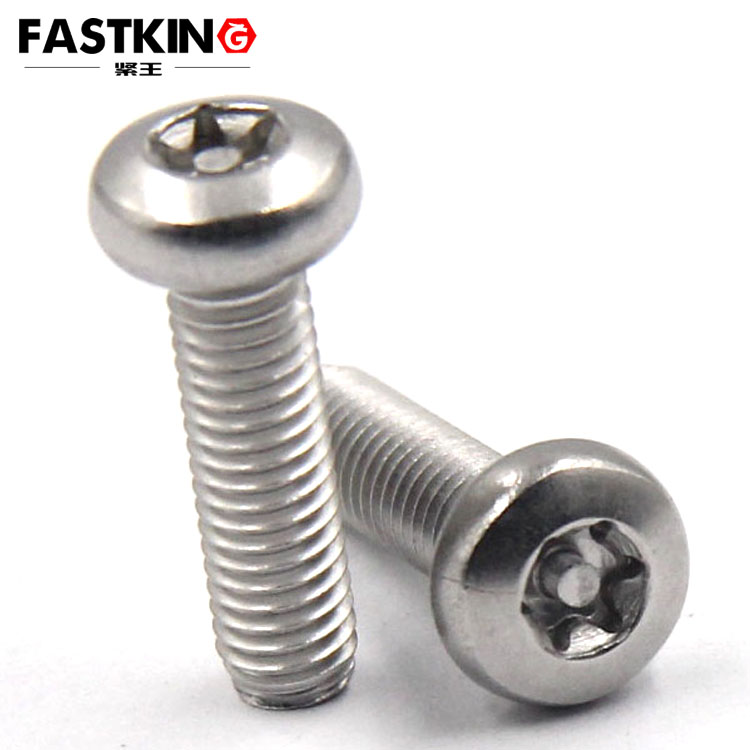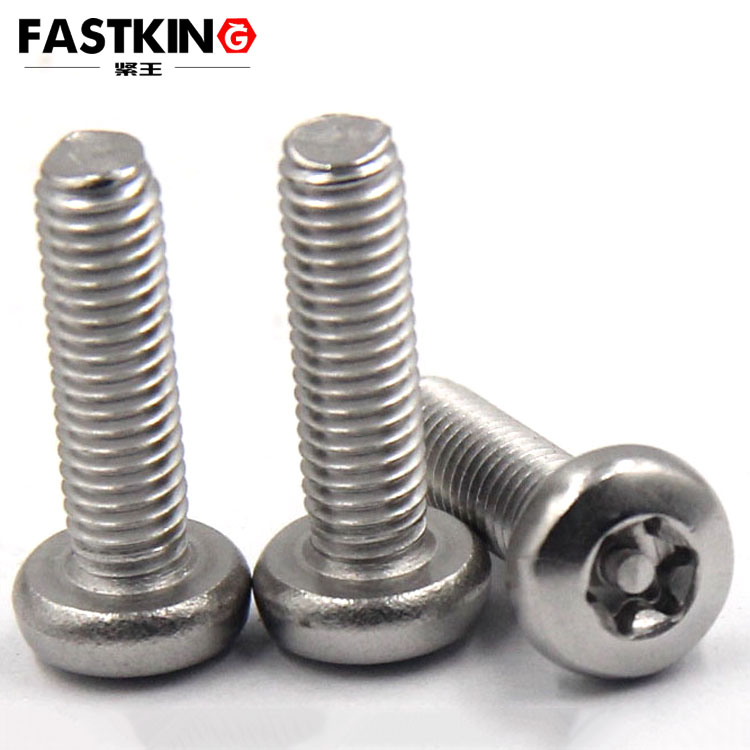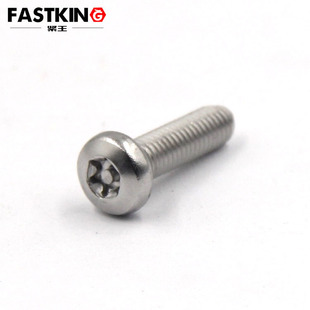- Torx screw,torx machine screw,torx self tapping screw
- sales@jlfastener.com
torx pan head machine screw with pin
Torx machine screw
torx pan head machine screw with pin
- Description:The dual attributes of "stable force-bearing + tamper-proof and anti-theft" make the pan-head inner plum blossom anti-theft bolt with a post a commonly used fastener in scenarios such as outdoor facil
I. Selection Tips: 3 Steps to Choose the Right Adapted Model
1. Determine Material Based on "Scenario Environment" to Avoid Insufficient Corrosion Resistance
- Outdoor humid/rainy scenarios (e.g., park benches, street lamp brackets): Prioritize 304 stainless steel. It contains chromium and nickel elements, which can form a dense oxide film to resist rain erosion and prevent rust failure within 1-2 years. If budget is limited, carbon steel + hot-dip galvanizing (zinc coating thickness ≥80μm) is an alternative, but rust protection must be inspected annually.
- Coastal salt spray scenarios (e.g., dock guardrails, offshore monitoring equipment): 316 stainless steel is a must. The addition of molybdenum increases its salt spray resistance by 2-3 times, allowing it to be used in salt spray environments for 3-5 years without obvious rust—avoiding rust spots that appear on ordinary stainless steel within 3-6 months.
- Indoor dry scenarios (e.g., file cabinets, gas meters): Q235 carbon steel is sufficient. Its cost is only half that of stainless steel. When combined with cold galvanizing or nickel plating, it meets basic anti-theft and short-term use needs, and its appearance better fits the texture of indoor equipment.
2. Determine Specifications Based on "Base Material and Load" to Prevent Force Failure
- Thread diameter matching base material thickness: For thin base materials (e.g., 1-2mm iron sheet distribution boxes), choose M4-M5 specifications to avoid crushing the base material due to excessive diameter. For thick base materials (e.g., 5mm solid wood benches, 8mm metal brackets), select M6-M8 specifications, ensuring the thread engagement depth is ≥3mm to prevent loosening.
- Do not ignore head height: For thin base materials (e.g., iron sheet nameplates), choose bolts with a head height of 2-3mm to avoid the head being too high, which may affect use or aesthetics. For thick base materials (e.g., equipment end caps), bolts with a head height of 4-5mm can be selected to increase the contact area and improve force stability.
- Post diameter must be precise: The post diameter must fully match the hole of the dedicated wrench (tolerance ≤0.1mm). For example, the common post diameter of M5 bolts is φ1.5mm. During selection, confirm the corresponding hole of the wrench to avoid problems such as "wrench cannot be inserted" or "slipping and damaging the post" later.
3. Choose Surface Treatment Based on "Aesthetics and Durability" to Balance Function and Appearance
- Outdoor scenarios: Hot-dip galvanizing (strong corrosion resistance, suitable for areas with heavy rain) or Dacromet treatment (salt spray resistance, suitable for coastal areas) is recommended. Nickel plating should be avoided, as it easily peels off outdoors and loses protection within 3-6 months.
- Indoor high-end equipment (e.g., smart home control panels): Nickel plating is suitable. Its silver appearance coordinates with the metallic texture of the equipment, and it is easy to clean, preventing oil adhesion.
- Dark-colored facilities (e.g., black fitness equipment): Black zinc treatment is a good choice. The black coating matches the color of the facilities, and its wear resistance is better than ordinary galvanizing, reducing appearance damage caused by daily friction.
II. Installation Tips: 4 Steps to Ensure Anti-Theft Performance and Stability
1. Tool Preparation: Dedicated Wrench is Key; "Modified Tools" are Prohibited
A dedicated inner plum blossom wrench with a post of the corresponding model must be used. Check if the diameter of the wrench's positioning post matches that of the bolt's post (judged by "no looseness when inserted"). Modifying ordinary inner plum blossom wrenches by grinding holes, or using pliers or screwdrivers for violent prying is prohibited—this will break the post, lose the anti-theft function, and may damage the bolt head, making later disassembly impossible.
2. Base Material Preparation: Different Operations for Different Materials to Avoid Damage
- Soft base materials (wood, plastic): Drill a hole first, with the hole diameter 0.5-1mm smaller than the thread diameter (e.g., drill a φ5.2-5.5mm hole for M6 bolts), then tap the thread with a tap. This prevents the base material from cracking or thread stripping caused by direct screwing.
-
Metal base materials: For pre-threaded holes, check if the threads are smooth. If there are burrs or deformation, repair them with a tap before installation. For non-threaded metal plates, drill a hole first (hole diameter 0.3-0.5mm smaller than the thread diameter), then tap the thread to ensure tight thread engagement.

3. Installation Operation: Torque Control is Core; Avoid Two Major Mistakes
- Vertical force application: Align the wrench vertically with the bolt head. Avoid inclined force application to prevent post breakage or head deformation. If vertical operation is impossible due to narrow space, use an elbow dedicated wrench—never force inclined screwing.
- Torque adaptation: Refer to torque standards (2-3N・m for M4 stainless steel bolts, 4-6N・m for M6 stainless steel bolts) and use a torque wrench to control the force. Avoid insufficient torque (which may cause loosening and falling off due to vibration in outdoor scenarios) or excessive torque (which may cause head cracking and post breakage, directly losing the anti-theft function).
4. Post-Installation Inspection: Do Not Miss 2 Details
- Check if the head is stable: No inclination or depression. Ensure uniform contact with the base material to disperse the load during force application and avoid local stress concentration.
- Test the anti-theft function: After installation, try to disassemble it with an ordinary inner plum blossom wrench. If it cannot be inserted or no force can be applied, the anti-theft function is normal. If it can be slightly twisted, recheck if the post is damaged or if the wrench matches.
III. Common Problem Solutions: Address 2 High-Frequency Issues
-
Post breakage: Mostly caused by excessive torque or mismatched wrenches. Replace with a new bolt, reinstall according to the standard torque, and ensure the wrench matches the post precisely.

- Rust and seizure of bolts: In outdoor scenarios, incorrect material selection (e.g., using carbon steel in coastal areas) easily leads to rust and seizure. During disassembly, use a dedicated wrench with a rust remover (e.g., WD-40), soak for 5-10 minutes, then twist slowly. Violent disassembly that damages the base material should be avoided.
The core of selecting and installing pan-head inner plum blossom anti-theft bolts with post lies in "precise matching" and "standardized operation". Choosing the right material and specifications, and installing according to the process with dedicated tools, can not only give full play to its advantages of force-bearing and anti-theft but also extend its service life, providing reliable protection for equipment safety.


